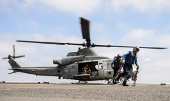
Differences Between True Flame-Resistant Military Clothing and Typical Flame-Retardant Apparel
Military personnel need gear that allows them to perform their duties effectively and efficiently under various environmental conditions, while remaining comfortable and safe.
- By Carolyn Kidd
- May 01, 2013
Military personnel require a variety of high quality, flame-resistant clothing options that comply with the standards of the U.S. Department of Defense (DOD). DOD and the protective apparel industry have made significant improvements during the past 10 years to protection, comfort, and durability in flame-resistant garments. These improvements can be seen not only within the DOD, but throughout the protective apparel world with agencies and protocols such as the National Fire Protection Association, OSHA, and Arc Flash Hazard Risk Category (HRC) garments.
Each of the organizations mentioned above sets its own standards in order to accomplish the needs of its respective end users. Likewise, the DOD standards sometimes differ from those set by OSHA and NFPA. Note some of these important points:
- NFPA sets forth two main standards: (1) NFPA 2112i advocates for flame-resistant garments that protect industrial personnel from flash fires; and (2) NFPA 2113 sets the standard for the selection, use, maintenance, and care of flame-resistant clothing used in industry.
- The OSHA 1910.269 maintenance standard, the OSHA general duty clause, and the OSHA 1910.119 process safety management regulation call for fire-retardant apparel for workers and the provision of adequate safety equipment in the workplace.
- Unlike the NFPA and OSHA standards that apply to the workplace, DOD standards for flame-resistant apparel apply only to the military. The military governs with military standards. One such specification, MIL-STD-3020, sets forth a flame-resistance acceptance level that involves testing on Navy surface ships, and that supersedes the requirements from the American Bureau of Shipping (ABS) and those in Appendix A of MIL-PRF-32161. This DOD standard establishes the requirement that fire protection materials, including acoustic insulation and thermal insulation, must be resistant to very high temperatures. This standard also applies to fire-resistant divisions made from aluminum, polymer, and steel composite structures. However, it does not address surface flame spread, ignitability, smoke density, and other basic or component design requirements.
- DOD standards require that all military apparel be 100 percent made in the USA (Berry Amendment compliant), whereas the OSHA and NFPA standards do not impose a rule on where flame-resistant clothing is manufactured.
Selection Considerations
Once these and other standards are met, how are various military flame-resistant fabrics distinguished and ranked for protection, durability, quality, etc.? Below are some points to consider, as well as differences between no-melt, no-drip, true flame-resistant clothing and typical fire-retardant clothing.
1. Variety of Apparel Choices. Military personnel need gear that allows them to perform their duties effectively and efficiently under various environmental conditions, while remaining comfortable and safe. Several reputable flame-resistant apparel manufacturers offer such quality products for the military. These manufacturers offer a wide range of flame-resistant clothing options including undergarments, layering shirts and tops, layering pants and bottoms, outerwear shirts and tops, outerwear bottoms and pants, flight suits, head protection gear, and combat apparel. The variety and quality of such apparel highlights the first distinction between no-melt, no-drip, true flame-resistant clothing and lesser-quality brands.
2. Protection for the Skin. No-melt, no-drip, inherently flame-resistant fabrics ensure that no military apparel fuses or melts onto the wearer's skin when exposed to a flame threat. This is in contrast to other garments that may be called flame-resistant yet still melt in high temperatures. In addition, true fire-protective clothing also features important comfort properties for military personnel, such as accessible pockets, soft fabrics, and no-rub shoulder seams, as well as a variety of fabric weights and layering options that assure protection in all climates and to all parts of the body, especially the neck and head. When military personnel are able to layer up or down to regulate their skin temperature and adjust protection levels based on specific conditions, they are better able to concentrate on situation awareness and minimize distractions.
3. New Technologies. The manufacturing of high-quality military apparel also incorporates new technologies that enable the fabrics to withstand adverse conditions. For example, patented moisture management allows for the quick absorption of moisture from the skin, drying the fabric faster and helping to regulate skin temperature in both cold and hot climates. In addition, antimicrobial protection inhibits the growth of bacteria and odor, allowing the wearer to stay fresh longer in situations without access to proper hygiene.
As demonstrated above, flame-resistant clothing for military personnel has undergone major improvements to ensure efficiency and effectiveness in modern warfare. In addition to increased durability and flexibility, new clothing technologies have produced fabrics that conserve the wearer's energy by regulating skin temperatures -- another clear difference between no-melt, no-drip, true flame-resistant clothing and regular fire-resistant clothing, which does not conserve body energy.
The most up-to-date flame-resistant military apparel is safer, lighter, and more comfortable compared to earlier garments and better able to withstand harsh conditions. These improvements support military personnel to carry out their duties with the best performance. When in combat, these fighters need to feel confident that their flame-resistant apparel protects them and provides the right features for the conditions.
This article originally appeared in the May 2013 issue of Occupational Health & Safety.